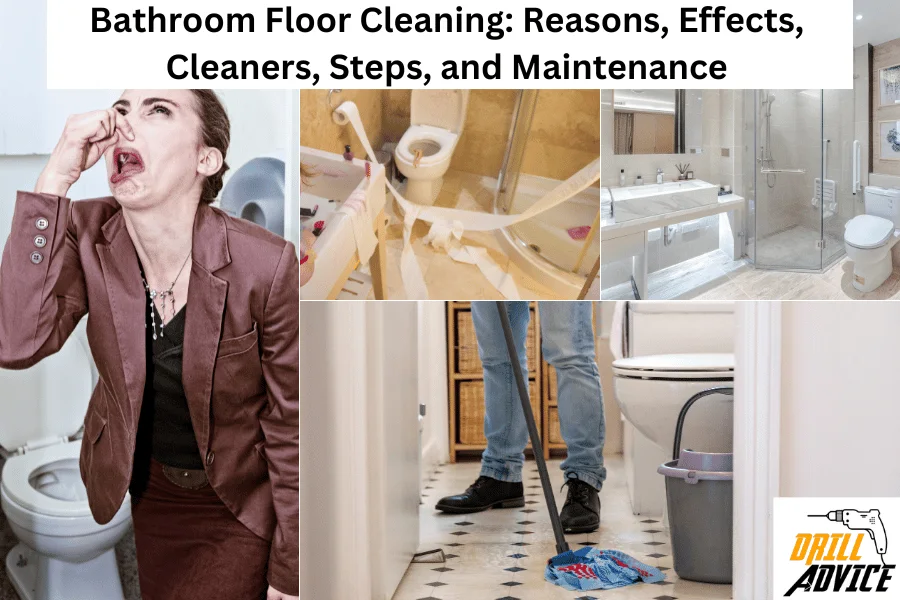
Bathroom floor cleaning helps to keep the bathroom more hygienic and pleasant. The bathroom floor can be dirt due to water contaminants such as calcium and magnesium, dust, soap scum, mold and mildew, hair and fur of the users. Due to this dirtiness, bathroom floors can be dirt and unpleasant place to the users.
The bathroom can have an unpleasant odor, slip and fall accidents, mold and mildew growth and stain are the bad effects fo the dirt bathroom floor. The bathroom floor can be cleaned using natural cleansers such as vinegar, lemon juice, and baking soda. The bathroom floor can be cleaned by using commercial cleaners also. Bathroom cleaning needs equipment such as a mop and bucket, steam cleaners, and microfiber mop.
When you clean the bathroom floor using vinegar, lemon juice, tile cleaner, baking soda, bleach, and ammonia, you should follow the below-mentioned effective steps. When you clean the bathroom floor, you should clean the grout lines also.
You should not use abrasive cleaners, harsh chemicals, steam cleaners, rough tools, and excessive water to clean the bathroom floor. These can damage the bathroom floor surface badly. By maintaining the bathroom floor by following these 5 steps: regular cleaning, avoiding harsh cleaners, wiping up spills immediately, using mats, and avoiding scratches, the bathroom floor can last long.
What Can Dirt the Bathroom Floor?
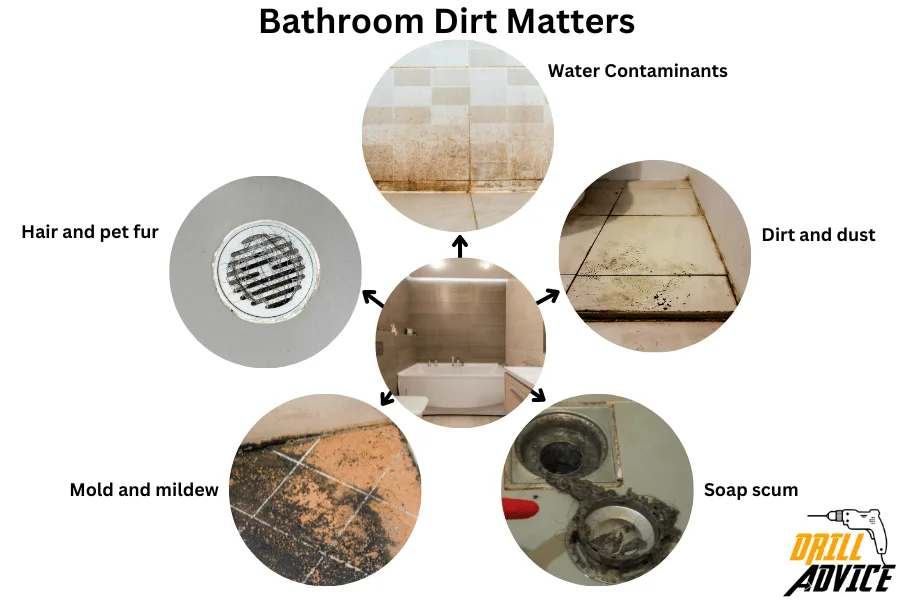
The bathroom floor can be dirt mainly due to dust, soap scum, mold and mildew, hair, and pet fur. These can make the bathroom floor more untidy and unpleasant. Due to these dirtiness germs and bacteria, algae can be grown easily.
- Water Contaminants – Tap water contains calcium and magnesium ions, which can make brown stain marks on the tile floor.
- Dirt and dust: Dirt and dust can accumulate on your bathroom floor over time due to using outside slippers into the bathroom. This can make your bathroom floor look dull and dirty.
- Soap scum: Soap scum is a common problem in bathrooms. It is a residue that is left behind when soap is mixed with hard water. When soap scum builds up on your bathroom floor, it makes a white layer.
- Mold and mildew: Bathrooms are prone to mold and mildew growth due to the high levels of moisture. If your bathroom floor is not properly ventilated, mold and mildew can grow on it.
- Hair and pet fur: If you have pets or long hair, you may find that your bathroom floor is covered in hair and fur. This can make your bathroom drains clog and block.
What Are the Bad Effects of Dirt Bathroom Floors?
The most problematic 4 bad effects of dirt bathroom floors are unpleasant odor, slip and fall accidents, mold and mildew growth, stain and discoloration.
- Unpleasant odor: Dirt and grime on your bathroom floor can give off an unpleasant odor that can make your bathroom smell bad.
- Slip and fall accidents: A dirty bathroom floor can be slippery, which increases the risk of slip and fall accidents. This is especially dangerous for children and elderly people.
- Mold and mildew growth: A dirty bathroom floor can provide the perfect breeding ground for mold and mildew. These fungi can cause a number of health problems, including respiratory issues and allergies.
- Stains and discoloration: Dirt and grime can cause stains and discoloration on your bathroom floor. This can make your bathroom look unsightly and can be difficult to clean.
What Can You Use for Bathroom Floor Cleaning?

When you clean the bathroom floor, you should use cleaners and cleaning equipment. Bathroom cleaners are mainly two types: natural cleaners and commercial cleaners. Natural cleaners are vinegar, lemon juice, and baking soda. Commercial cleaners are bleach ammonia. Mop and bucket, stem cleaners, floor cleaning machines, and microfiber mops are bathroom floor cleaning equipment.
Bathroom Floor Cleaners
When you Clean the bathroom floor, you can use these 7 bathroom floor cleaners.
- Vinegar
- Lemon Juice
- Tile cleaner
- Baking Soda
- Bleach
- Ammonia
- Commercial Cleaners
Bathroom Floor Cleaning Equipment
- Mop and bucket: You can use a variety of cleaning solutions with a mop and bucket, including water and vinegar, bleach, or a commercial floor cleaner.
- Steam cleaner: A steam cleaner is a great tool for deep-cleaning your bathroom floor. It uses high-pressure steam to remove dirt, grime, and bacteria from your floor without the need for chemicals. Steam cleaners are especially useful for those with allergies or sensitivities to cleaning products.
- Floor cleaner machine: Floor cleaner machines use a combination of water and cleaning solutions to scrub your floors and then suction up the dirty water.
- Microfiber mop: A microfiber mop is a newer option for cleaning bathroom floors. These mops are designed to be more effective at picking up dirt and grime than traditional mops.
Read More About
- Bathroom Toilet Cleaning: Reasons, Equipment, Steps and Maintenance
- Bathtub Cleaning: Reasons, Equipment, Steps and Maintenance
How to Clean Bathroom Floor Using Different Cleaners?
1. Cleaning Bathroom Floor Using Vinegar
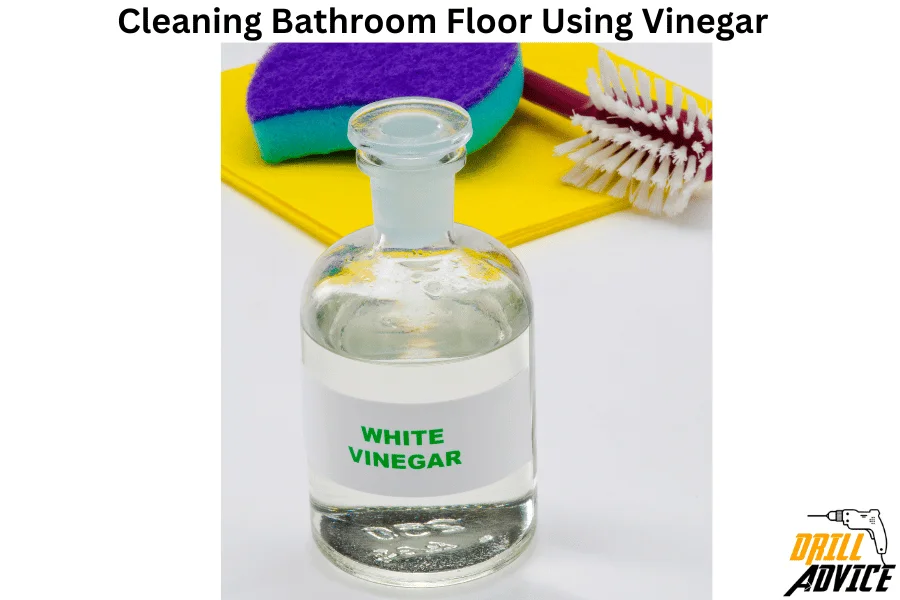
Vinegar is a natural and effective cleaner that can be used to clean bathroom floor. To use vinegar to clean your bathroom floor, follow these 4 effective steps:
- Step 1 – Mix equal parts water and vinegar in a bucket.
- Step 2 – Dip a mop or cloth into the solution and wring it out.
- Step 3 – Use the mop or cloth to clean the bathroom floor, paying special attention to any dirty or stained areas.
- Step 4 – Rinse the floor with clean water and dry it with a clean cloth.
2. Cleaning Bathroom Floor Using Lemon Juice
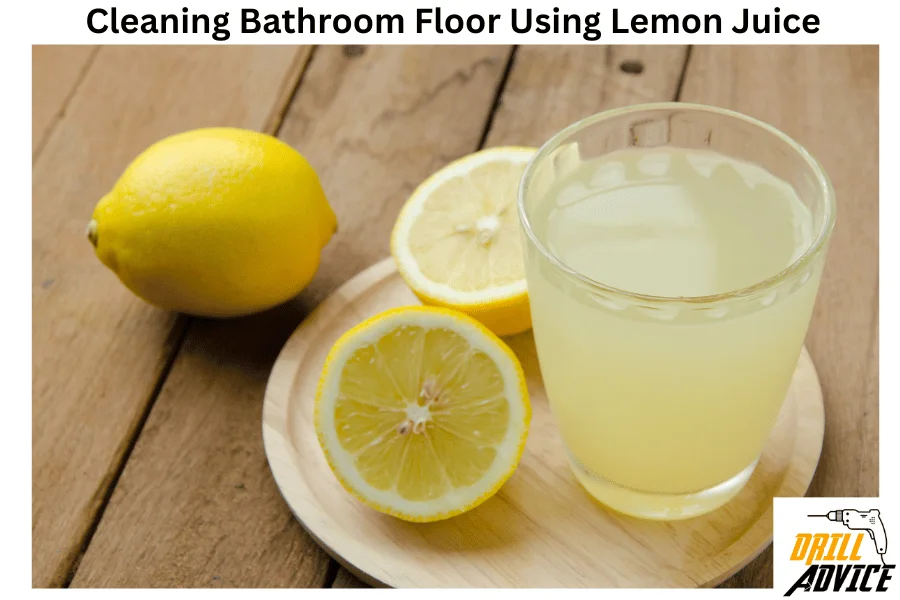
Lemon juice is a natural cleaner that can be used to clean bathroom floors. It is particularly effective on stains and grime. Follow these 4 effective steps to use lemon juice to clean your bathroom floor,
- Step 1 – Mix equal parts lemon juice and water in a bucket.
- Step 2 – Dip a mop or cloth into the solution and wring it out.
- Step 3 – Use the mop or cloth to clean the bathroom floor, paying special attention to any dirty or stained areas.
- Step 4 – Rinse the floor with clean water and dry it with a clean cloth.
3. Cleaning Bathroom Floor Using Tile Cleaner
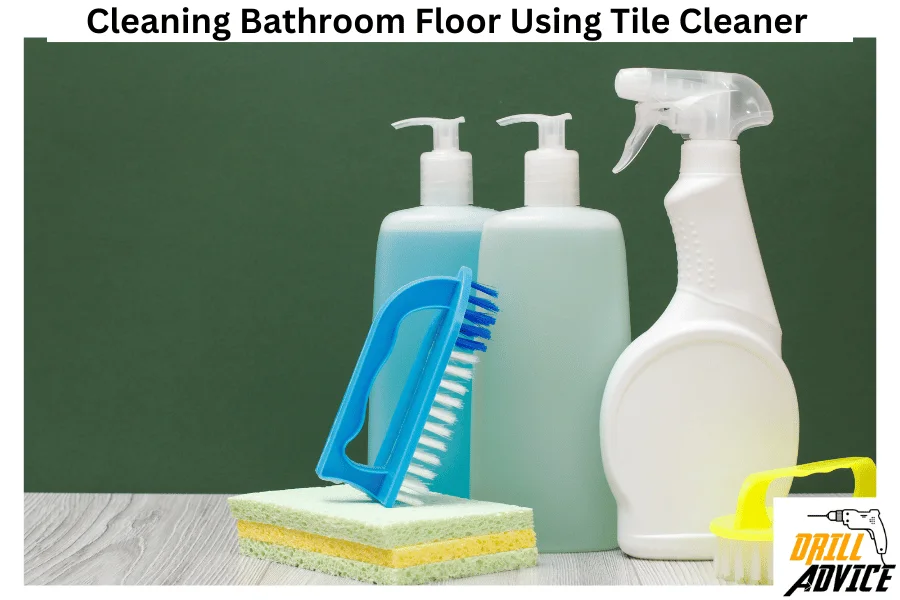
Tile cleaner is a commercial cleaner. Tile cleaners are specifically designed to clean tile floors. It is effective at removing dirt, grime, and stains. To use tile cleaner to clean your bathroom floor, follow these 5 effective steps:
- Step 1 – Read the instructions on the tile cleaner bottle.
- Step 2 – Mix the cleaner with water according to the instructions.
- Step 3 – Apply the cleaner to the bathroom floor using a mop or cloth.
- Step 4 – Use a scrub brush to scrub any dirty or stained areas.
- Step 5 – Rinse the floor with clean water and dry it with a clean cloth.
4. Cleaning Bathroom Floor Using Baking Soda
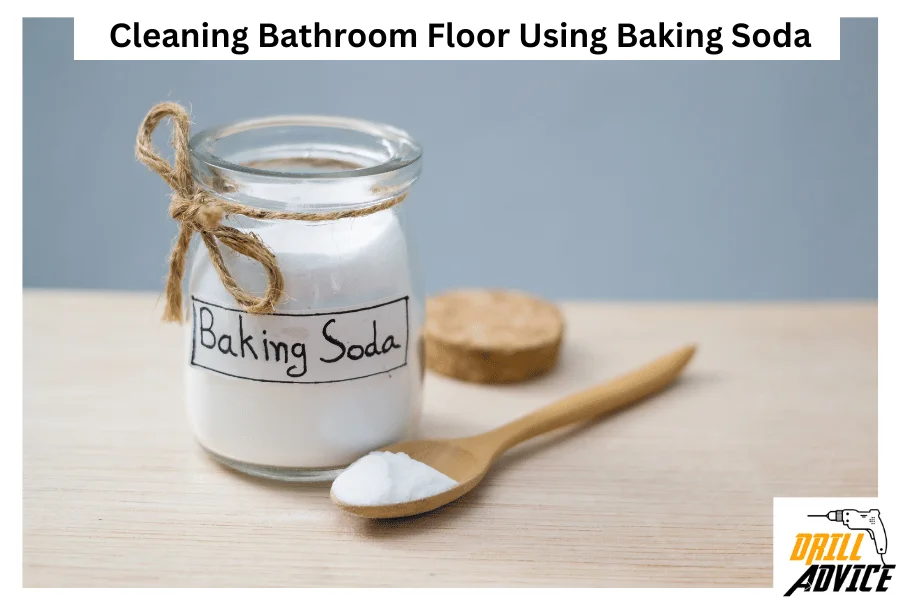
Baking soda is a natural cleaner that can be used to clean bathroom floor surface. It is particularly effective at removing odors. You should follow these 4 effective steps when you clean your bathroom floor.
- Step 1 – Mix baking soda with water to form a paste.
- Step 2 – Apply the paste to the bathroom floor using a sponge or cloth.
- Step 3 – Use a scrub brush to scrub any dirty or stained areas.
- Step 4 – Rinse the floor with clean water and dry it with a clean cloth.
5. Cleaning Bathroom Floor Using Bleach

Bleach is a powerful cleaner that can be used to clean bathroom floors. It is effective at removing stains and disinfecting surfaces. These 5 effective steps help to clean your bathroom floor.
- Step 1 – Read the instructions on the bleach bottle.
- Step 2 – Mix the bleach with water according to the instructions.
- Step 3 – Apply the bleach solution to the bathroom floor using a mop or cloth.
- Step 4 – Use a scrub brush to scrub any dirty or stained areas.
- Step 5 – Rinse the floor with clean water and dry it with a clean cloth.
6. Cleaning Bathroom Floor Using Ammonia
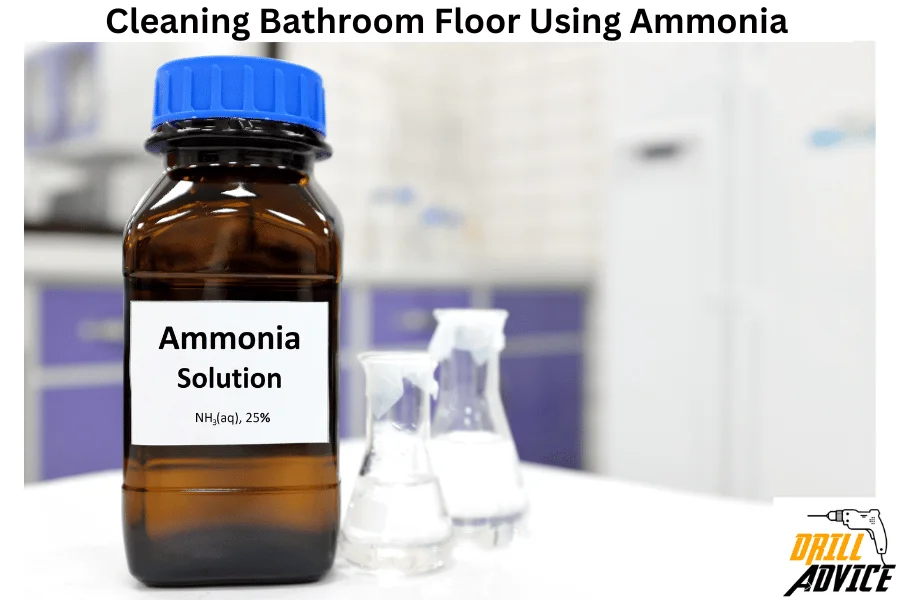
Ammonia is a strong cleaner that can be used to clean bathroom floors. It is effective at removing dirt, grime, and stains. You should follow these 5 effective steps when you clean your bathroom floor.
- Step 1 – Read the instructions on the ammonia bottle.
- Step 2 – Mix the ammonia with water according to the instructions.
- Step 3 – Apply the ammonia solution to the bathroom floor using a mop or cloth.
- Step 4 – Use a scrub brush to scrub any dirty or stained areas.
- Step 5 – Rinse the floor with clean water and dry it with a clean cloth.
How to Clean the Bathroom Floor Grout?

Bathroom floor grout is a porous material. Hence it absorbs dirt and grimes easily. Those will be a growing place to bacteria and germs. Hence, grout should be cleaned properly. The bathroom floor can be cleaned using these 6 effective steps.
- Step 1 – Gather your cleaning supplies: You will need a grout cleaner, a stiff-bristled brush, a bucket, and a mop.
- Step 2 – Apply the grout cleaner: Follow the instructions on the cleaner and apply it to the grout lines. Be sure to wear gloves and work in a well-ventilated area.
- Step 3 – Scrub the grout lines: Use a stiff-bristled brush to scrub the grout lines. Focus on the areas that are the dirtiest or discolored. Apply more cleaner as needed.
- Step 4 – Rinse the floor: Use a mop and clean water to rinse the floor. Be sure to rinse thoroughly to remove all of the cleaner.
- Step 5 – Dry the floor: Use a clean towel or mop to dry the floor. This will help prevent any water spots or streaks from forming.
- Step 6 – Maintain the grout: To keep your grout looking clean and healthy, it’s important to maintain it regularly. This means wiping up any spills or messes as soon as possible and using a grout sealer every six months to a year.
What You Should Not Use for Bathroom Floor Cleaning?
The bathroom floor can be damaged by using the wrong type of cleaner or tools.
1. Abrasive Cleaners
Avoid using abrasive cleaners like scouring powders, steel wool, or abrasive scrubbing pads. These can scratch and damage the surface of your bathroom floor. Instead, use a mild cleaner that is safe for your specific type of flooring.
2. Harsh Chemicals
Harsh chemicals like bleach, ammonia, and acid-based cleaners can be harmful to your health and damage your bathroom floor. These chemicals can cause discoloration, etching, or even deterioration of the flooring material.
3. Steam Cleaners on Vinyl or laminate flooring
Although steam cleaners are great for deep cleaning, they can be harmful to certain types of bathroom flooring. Steam can penetrate the seams of vinyl or laminate flooring and cause them to warp or buckle. Avoid using steam cleaners on these types of flooring and opt for a safer alternative.
4. Rough Tools
Using rough tools like hard-bristled brushes or metal scrapers can scratch or damage your bathroom floor. Instead, use a soft-bristled brush or a mop with a microfiber head to gently clean your flooring.
5. Excessive Water
Using too much water when cleaning your bathroom floor can cause damage to certain types of flooring. Excess water can seep into the seams of vinyl or laminate flooring and cause them to warp or buckle. Use a damp mop or cloth to clean your flooring and avoid using excessive amounts of water.
How to Maintain Bathroom Floor Properly?
To keep your bathroom floor looking clean and new, you must maintain it properly. Here are a few tips to help you do so:
- Regular Cleaning: Regular cleaning is important to maintain the bathroom floor. You should sweep or vacuum the floor daily to remove dirt and debris. Additionally, you should mop the floor with a mild cleaner once a week to remove any stains or dirt that has accumulated.
- Avoid Harsh Cleaners: Harsh cleaners can damage the surface of the bathroom floor. You should avoid using bleach or ammonia-based cleaners. Instead, use mild cleaners that are specifically designed for bathroom floors.
- Wipe Up Spills Immediately: Spills can cause stains on the bathroom floor. You should wipe up any spills immediately to prevent them from staining the floor.
- Use Mats: Mats can help protect the bathroom floor from water damage. You should place mats near the shower and sink to absorb any water that may splash onto the floor.
- Avoid Scratching: Scratching can damage the surface of the bathroom floor. You should avoid dragging heavy objects across the floor and use furniture pads to protect the floor from scratches.
